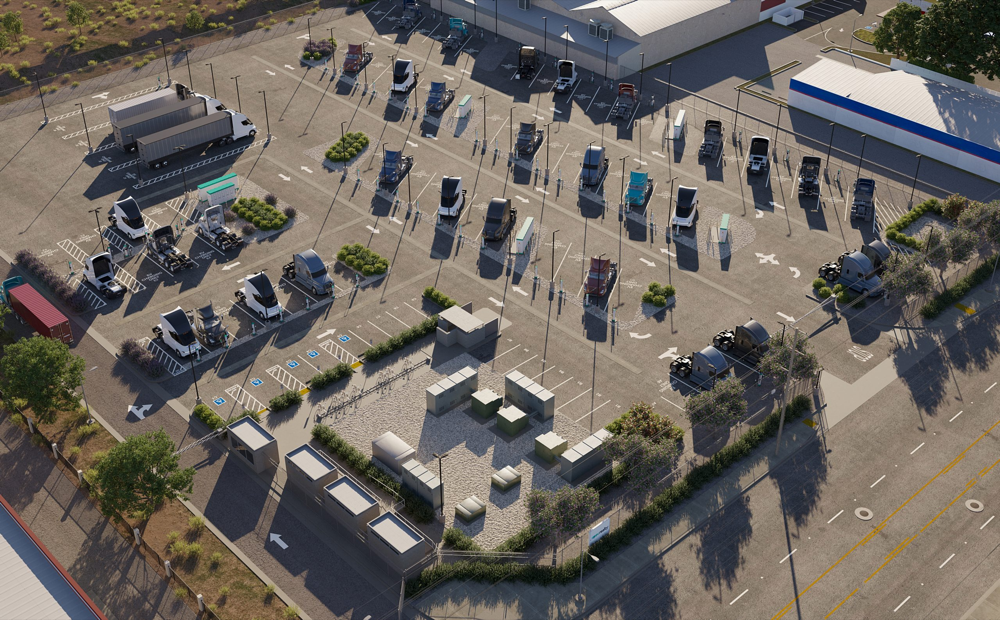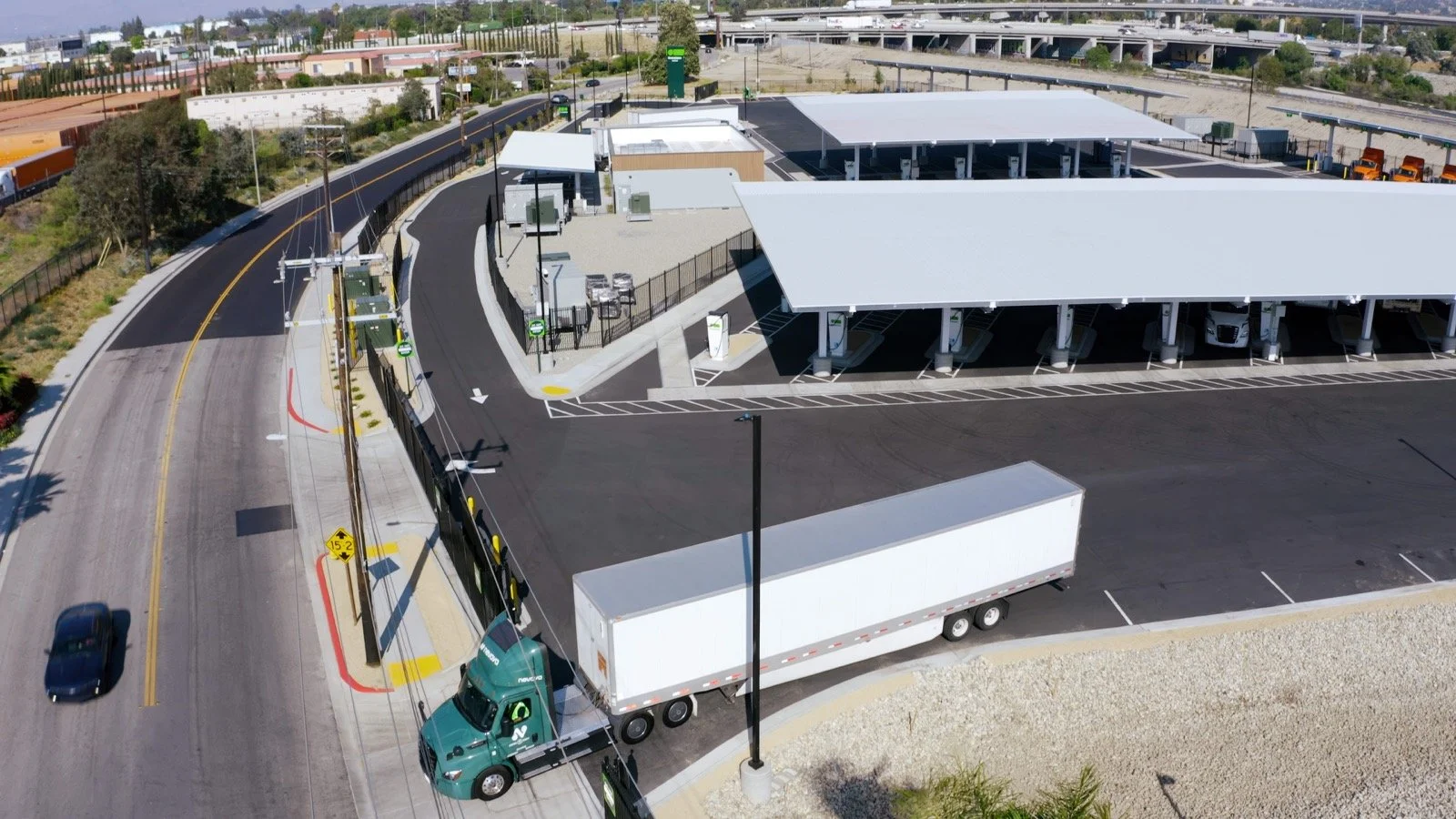Light-Duty vs. Medium- and Heavy-Duty Charging: Why One-Size-Fits-All Won’t Work
Picture an electric vehicle charging site the size of several football fields, where dozens of big rigs plug into high-powered chargers at once. Each truck draws hundreds of kilowatts, pushing total site demand into the multi-megawatt range—the equivalent of powering a small town. This is heavy-duty truck electrification, and it looks nothing like charging a passenger EV.
Electrifying medium- and heavy-duty (M/HD) fleets requires a different playbook. From siting and power needs to scheduling and operations, truck charging reshapes how networks and grid connections are planned, financed, and managed. Light-duty charging feels almost like a low-lift in comparison—quicker to install, easier to use, and far less demanding on the grid. When it comes to commercial trucking, one size won’t fit all.
Different Trucks, Different Charging Needs
Vehicles are grouped into Classes 1 through 8, based on their gross vehicle weight (GVWR):
Classes 1 - 2 (Light-Duty): Cars, SUVs, pickups, small vans, step or utility vans
Classes 3 - 6 (Medium-Duty): Local delivery trucks, like those used by Amazon, FedEx, or UPS
Classes 7 - 8 (Heavy-Duty): Long-haul semis, garbage trucks, cement mixers, drayage trucks
PACT focuses primarily on Classes 6–8. These trucks run a range of routes—from long-haul and port drayage to regional distribution and municipal services—so charging must be built around operations. The diversity of duty cycles and fleet needs calls for a range of solutions, not a universal approach.
There’s No Such Thing as an “Average Truck”
When it comes to commercial vehicles, average doesn’t exist. Trucks are engineered to meet the specific needs of their operators—payload, range, route type, and dwell time. Such diversity means that two fleets, or even two Class 8 trucks, seldom behave the same when it comes to charging.
A long-haul truck might recharge quickly along a highway corridor, while a drayage truck serving nearby warehouses can plug in for several hours at a lower-power depot. Step vans, refuse trucks, and regional haulers add their own variations. The result is a highly diversified set of load profiles shaped by real-world operations.
To serve that range, the industry is aligning around a spectrum of charging solutions. Some fleets need high-power charging between runs; others rely on lower-power chargers for overnight dwell times. Shared facilities are emerging as flexible hubs where fleets with different duty cycles can plug in side by side.
This complexity challenges how utilities plan and price electricity. Unlike passenger EVs, which follow predictable residential patterns, commercial vehicle load profiles are uneven and time-sensitive, often conflicting with one-size-fits-all tariffs and incentive programs.
Meeting these needs requires serious grid infrastructure. Typical M/HD depots draw 2–10 MW, with the largest reaching 20 MW or more—enough to power thousands of homes. Each connection demands close coordination with utilities to design and install transformers, feeders, or even substations. These are often multi-year infrastructure projects, not plug-and-play installations.
Location, Location, Location
Charging isn’t just about plugs and wires—it’s about place. The nation’s freight network is built around fixed infrastructure—ports, intermodal yards, warehouses, and major highway interchanges. These are the same nodes that have moved goods for decades and will continue to do so in an electric future. Because these networks anchor where trucks operate, charging hotspots are already well defined: ports, distribution centers, and heavily trafficked freight corridors. These locations aren’t going anywhere, making them the most reliable places to invest in charging.
Depot charging—either private or shared—will serve the majority of fleet demand.1 These facilities sit near fleet yards, warehouses, and ports where trucks dwell for hours at a time.2
Forum Mobility’s FM Harbor Depot at the Port of Long Beach is a 9 MW, 44-charger site designed specifically for drayage fleets.
EV Realty’s hub in San Bernardino (slated to open later this year) will feature 76 ports, backed by 9.9 MW of power, and is strategically located near major freight corridors, airports, intermodal facilities, and key routes to the Ports of Los Angeles and Long Beach.
For longer routes, en-route charging—typically at public or multi-use hubs—provides flexibility. These sites function like today’s fueling stations but require far more land and power.
Greenlane’s Colton site in Southern California exemplifies this model: a strategically located corridor hub serving regional-haul and long-distance trucks that need fast, reliable charging between metro areas.
Depot and en-route sites aren’t competing—they’re complementary parts of the same connected network.
Depot Layout and Operations
Designing a heavy-duty charging depot is as much about logistics as it is about electricity. Unlike light-duty chargers that fit into parking lots or garages, M/HD depots must accommodate the size and maneuvering needs of large trucks—wide aisles, high clearances, and room for safe ingress and egress.
Because these are critical business operations, sites also require robust safety, security, and operational systems—fencing, lighting, surveillance, controlled access, and trained staff to manage traffic and maintenance.
Payment systems are another key difference. Passenger EV drivers tap a credit card, but fleets often depend on automated, back-end billing systems integrated with fleet management software for seamless, pre-negotiated transactions.
Together, these features make depot design far more complex, and reinforce that truck charging isn’t just a scaled-up version of passenger EV charging, but a new class of industrial infrastructure entirely.
Why Certainty is Everything
For fleets, certainty is the bottom line. Truck operators live or die by predictability—routes, schedules, delivery windows, and now, charging. Operators need to know sites will be energized on time, chargers will be available when promised, and charger uptime will meet demanding expectations. Without that assurance, the business case for electrification falls apart.
The old adage still applies: “If the wheels aren’t turning, you’re not earning.” In an electric world, that means every link in the chain—energization timelines, grid capacity, equipment availability and reliability, and power costs—must align. If any one fails, operations grind to a halt.
Leading developers, including many PACT members, are designing for certainty from day one: securing grid capacity early, structuring service-level agreements (SLAs) to ensure charger availability, and staffing on-site maintenance teams. Many sites now include battery storage or on-site generation to accelerate deployments, buffer outages, manage demand peaks, and stabilize costs.
Certainty isn’t a luxury—it’s the currency that drives adoption. When developers and utilities deliver reliable power, fleets can invest with confidence.
Building Certainty for the Road Ahead
Freight electrification demands more than bigger chargers. It requires rethinking how infrastructure is sited, financed, connected, and operated.
The fleets and developers who combine smart site planning, resilient operations, and proactive utility partnerships will lead the transition. Building reliable, large-scale truck charging isn’t just about clean energy—it’s about powering America’s supply chains and keeping goods moving in a zero-emission future.
At PACT, we’re working to make that future possible—by aligning fleets, utilities, regulators, and developers around one goal: certainty of power, place, and partnership.
This content was informed by PACT members from EV Realty and Forum Mobility.




